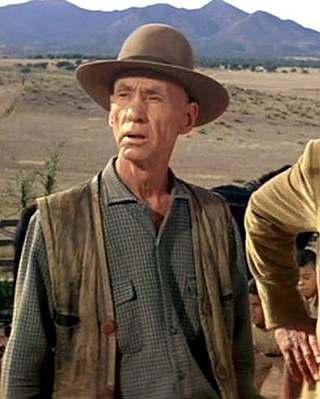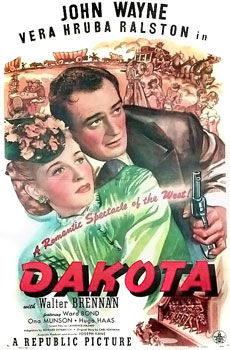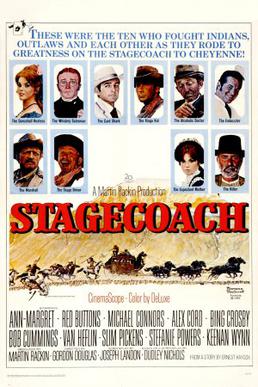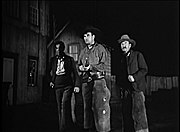
Lordsburg is a city in and the county seat of Hidalgo County, New Mexico, United States. Hidalgo County includes the southern "bootheel" of New Mexico, along the Arizona border. The population was 2,797 at the 2010 census, down from 3,379 in 2000.

John Martin Feeney, known professionally as John Ford, was an American film director and producer. He is regarded as one of the most important and influential filmmakers during the Golden Age of Hollywood, and was one of the first American directors to be recognized as an auteur. In a career of more than 50 years, he directed over 140 films between 1917 and 1965, and received six Academy Awards including a record four wins for Best Director for The Informer (1935), The Grapes of Wrath (1940), How Green Was My Valley (1941), and The Quiet Man (1952).

Monument Valley is a region of the Colorado Plateau characterized by a cluster of sandstone buttes, the largest reaching 1,000 ft (300 m) above the valley floor. The most famous butte formations are located in northeastern Arizona along the Utah–Arizona state line. The valley is considered sacred by the Navajo Nation, the Native American people within whose reservation it lies.

Rio Grande is a 1950 American romantic Western film directed by John Ford and starring John Wayne and Maureen O'Hara. It is the third installment of Ford's "Cavalry Trilogy", following two RKO Pictures releases: Fort Apache (1948) and She Wore a Yellow Ribbon (1949). Wayne plays the lead in all three films, as Captain Kirby York in Fort Apache, then as Captain Nathan Brittles in She Wore a Yellow Ribbon, and finally as a promoted Lieutenant Colonel Kirby Yorke in Rio Grande. Rio Grande's supporting cast features Ben Johnson, Claude Jarman Jr., Harry Carey Jr., Chill Wills, J. Carrol Naish, Victor McLaglen, Grant Withers, the Western singing group the Sons of the Pioneers and Stan Jones.

Benjamin Franklin "Frank" McGrath was an American television and film actor and stunt performer who played the comical, optimistic cook with the white beard, Charlie B. Wooster, on the western series Wagon Train for five seasons on NBC and then three seasons on ABC. McGrath appeared in all 272 episodes in the eight seasons of the series, which had ended its run only two years before his death. McGrath's Wooster character hence provided the meals and companionship for both fictional trail masters, Ward Bond as Seth Adams and John McIntire as Christopher "Chris" Hale.

Tom Tyler was an American actor known for his leading roles in low-budget Western films in the silent and sound eras, and for his portrayal of superhero Captain Marvel in the 1941 serial film The Adventures of Captain Marvel. Tyler also played Kharis in 1940's The Mummy's Hand, a popular Universal Studios monster film.
Ernest James Haycox was an American writer of Western fiction.

3:10 to Yuma is a 1957 American Western film directed by Delmer Daves, starring Glenn Ford and Van Heflin. Based on a 1953 short story by Elmore Leonard, it is about a drought-impoverished rancher who takes on the risky job of escorting a notorious outlaw to justice.

Fort Apache is a 1948 American Western film directed by John Ford and starring John Wayne and Henry Fonda. The film was the first of the director's "Cavalry Trilogy" and was followed by She Wore a Yellow Ribbon (1949) and Rio Grande (1950), both also starring Wayne. The screenplay was inspired by James Warner Bellah's short story "Massacre" (1947). The historical sources for "Massacre" have been attributed both to George Armstrong Custer and the Battle of Little Bighorn and to the Fetterman Fight.

Hank Worden was an American cowboy-turned-character actor who appeared in many Westerns, including many John Ford films such as The Searchers and the TV series The Lone Ranger.

Union Pacific is a 1939 American Western drama directed by Cecil B. DeMille and starring Barbara Stanwyck, Joel McCrea and Robert Preston. Based on the 1936 novel Trouble Shooter by Western fiction author Ernest Haycox, the film is about the building of the eponymous railroad across the American West. Haycox based his novel upon the experiences of civil engineer Charles H. Sharman, who worked on the railroad from its start in Omaha, Nebraska in 1866 until the golden spike ceremony on May 10, 1869 to commemorate the joining of the Central Pacific and Union Pacific railroads at Promontory Summit, Utah Territory. The film recreates the event using the same 1869 golden spike, on loan from Stanford University.

Hondo is a 1953 Warnercolor 3D Western film directed by John Farrow and starring John Wayne and Geraldine Page. The screenplay is based on the 1952 Collier's short story "The Gift of Cochise" by Louis L'Amour. The book Hondo was a novelization of the film also written by L'Amour, and published by Gold Medal Books in 1953. The supporting cast features Ward Bond, James Arness and Leo Gordon.

Geronimo: An American Legend is a 1993 historical Western film starring Wes Studi, Jason Patric, Gene Hackman, Robert Duvall, and Matt Damon in an early role. The film, which was directed by Walter Hill, is based on a screenplay by John Milius. It is a fictionalized account of the Apache Wars and how First Lieutenant Charles B. Gatewood convinced Apache leader Geronimo to surrender in 1886.

Red River Range is a 1938 "Three Mesquiteers" Western film starring John Wayne, Ray Corrigan, Max Terhune, and Polly Moran. Wayne played the lead in eight of the fifty-one movies in the popular series. The director was George Sherman.

Dakota is a 1945 American Western film directed by Joseph Kane, and starring John Wayne. The supporting cast features Walter Brennan, Ward Bond, and Mike Mazurki.

Stagecoach is a 1966 American Western film, directed by Gordon Douglas between July and September 1965, as a color remake of the Academy Award-winning John Ford 1939 classic black-and-white western Stagecoach. Unlike the original version which listed its ten leading players in order of importance, the major stars are billed in alphabetical order.

Stagecoach is a 1986 American made-for-television Western action drama film and remake of the classic 1939 film Stagecoach, directed by Ted Post and starring Kris Kristofferson as the Ringo Kid, the role originally played by John Wayne. Willie Nelson portrays famous gunslinger and dentist Doc Holliday, Johnny Cash portrays Marshal Curly Wilcox and Waylon Jennings plays the gambler Hatfield. The four main stars of the film were associated as members of the country music supergroup The Highwaymen. The supporting cast features Elizabeth Ashley, Anthony Newley, Tony Franciosa, Mary Crosby, June Carter Cash and Jessi Colter.

Ned Scott was an American photographer who worked in the Hollywood film industry as a still photographer from 1935 to 1948. As a member of the Camera Club of New York from 1930 to 1934, he was heavily influenced by fellow members Paul Strand and Henwar Rodakiewicz.

Apache War Smoke is a 1952 American Western film directed by Harold F. Kress and starring Gilbert Roland, Glenda Farrell, and Robert Horton. The film is based on the 1939 short story "Stage Station" by Ernest Haycox. It was released by MGM on September 25, 1952. An outlaw murders several Apaches and flees to a stagecoach station with the tribe in hot pursuit.
Apache Wells is the name of both fictional and real locations in southern Arizona.





























